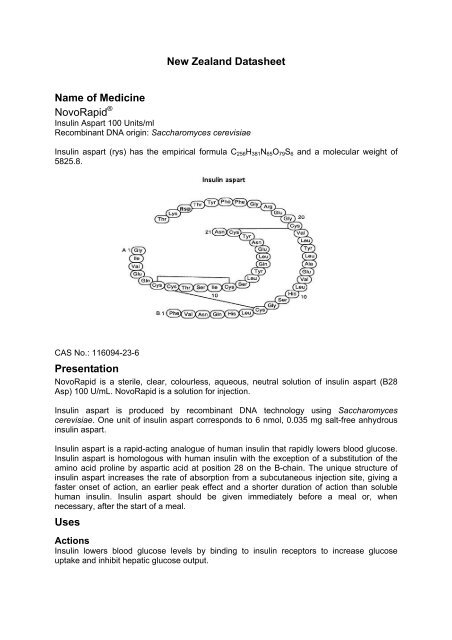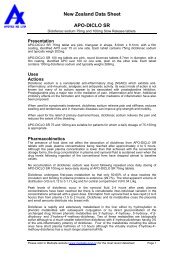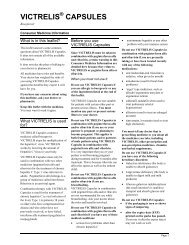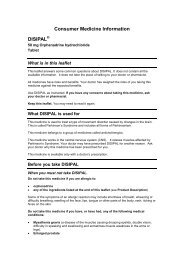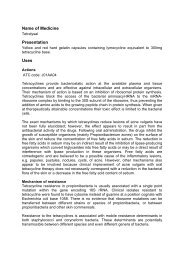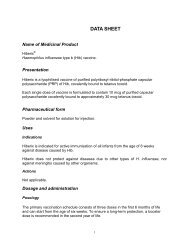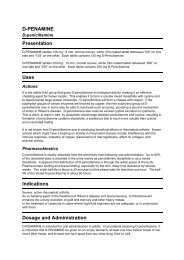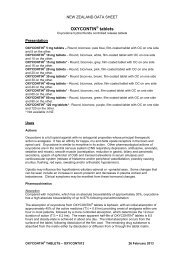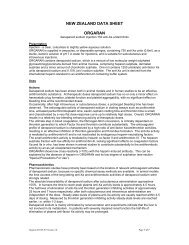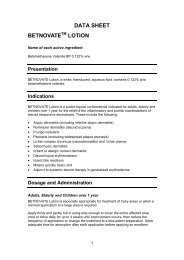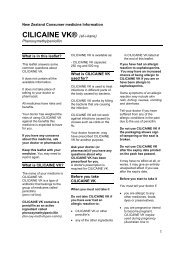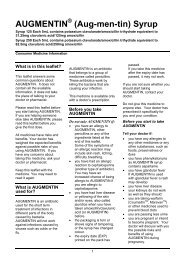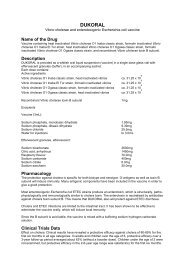New Zealand Datasheet Name of Medicine NovoRapid - Medsafe
New Zealand Datasheet Name of Medicine NovoRapid - Medsafe
New Zealand Datasheet Name of Medicine NovoRapid - Medsafe
Create successful ePaper yourself
Turn your PDF publications into a flip-book with our unique Google optimized e-Paper software.
<strong>New</strong> <strong>Zealand</strong> <strong>Datasheet</strong><br />
<strong>Name</strong> <strong>of</strong> <strong>Medicine</strong><br />
<strong>NovoRapid</strong> ®<br />
Insulin Aspart 100 Units/ml<br />
Recombinant DNA origin: Saccharomyces cerevisiae<br />
Insulin aspart (rys) has the empirical formula C256H381N65O79S6 and a molecular weight <strong>of</strong><br />
5825.8.<br />
CAS No.: 116094-23-6<br />
Presentation<br />
<strong>NovoRapid</strong> is a sterile, clear, colourless, aqueous, neutral solution <strong>of</strong> insulin aspart (B28<br />
Asp) 100 U/mL. <strong>NovoRapid</strong> is a solution for injection.<br />
Insulin aspart is produced by recombinant DNA technology using Saccharomyces<br />
cerevisiae. One unit <strong>of</strong> insulin aspart corresponds to 6 nmol, 0.035 mg salt-free anhydrous<br />
insulin aspart.<br />
Insulin aspart is a rapid-acting analogue <strong>of</strong> human insulin that rapidly lowers blood glucose.<br />
Insulin aspart is homologous with human insulin with the exception <strong>of</strong> a substitution <strong>of</strong> the<br />
amino acid proline by aspartic acid at position 28 on the B-chain. The unique structure <strong>of</strong><br />
insulin aspart increases the rate <strong>of</strong> absorption from a subcutaneous injection site, giving a<br />
faster onset <strong>of</strong> action, an earlier peak effect and a shorter duration <strong>of</strong> action than soluble<br />
human insulin. Insulin aspart should be given immediately before a meal or, when<br />
necessary, after the start <strong>of</strong> a meal.<br />
Uses<br />
Actions<br />
Insulin lowers blood glucose levels by binding to insulin receptors to increase glucose<br />
uptake and inhibit hepatic glucose output.
As with all insulins in clinical practice, the duration <strong>of</strong> action <strong>of</strong> insulin aspart will vary<br />
according to the dose, injection site, blood flow, temperature and level <strong>of</strong> physical activity.<br />
Insulin aspart is equipotent to soluble human insulin on a molar basis.<br />
<strong>NovoRapid</strong> produces a more rapid and pronounced blood glucose lowering effect than<br />
soluble human insulin, due to the faster onset <strong>of</strong> action.<br />
<strong>NovoRapid</strong> has a shorter duration <strong>of</strong> action compared to soluble human insulin after<br />
subcutaneous injection (Fig.1).<br />
When administered immediately before a meal, the effect <strong>of</strong> <strong>NovoRapid</strong> more closely mimics<br />
normal physiological postprandial insulin release than soluble human insulin.<br />
The onset <strong>of</strong> action <strong>of</strong> <strong>NovoRapid</strong> occurs within 10-20 minutes <strong>of</strong> subcutaneous injection.<br />
The maximum effect is exerted between 1 and 3 hours after injection. The duration <strong>of</strong> action<br />
is 3 to 5 hours. <strong>NovoRapid</strong> has a more predictable time to peak effect within subjects than<br />
soluble human insulin.<br />
Fig. 1: Blood glucose concentrations* (mean +/- 2SEM) following a single pre-meal dose<br />
(0.15 U/kg) <strong>of</strong> <strong>NovoRapid</strong> injected immediately before a meal (solid curve) or soluble human<br />
insulin administered 30 minutes before a meal (dashed curve) in patients with type 1<br />
diabetes mellitus.<br />
Blood<br />
glucose<br />
(mmol/L)<br />
16<br />
14<br />
12<br />
10<br />
8<br />
6<br />
4<br />
2<br />
0<br />
0 1 2 3 4 5<br />
Time (h)<br />
Pharmacokinetics<br />
Human insulin molecules self-associate to form hexamers. The substitution <strong>of</strong> proline by<br />
aspartic acid at position B28 in insulin aspart produces an intermolecular repulsion which<br />
reduces the tendency <strong>of</strong> the insulin molecules to self-associate. This increases the rate <strong>of</strong><br />
dissociation <strong>of</strong> hexamers into dimers and monomers in the subcutaneous layer.<br />
<strong>NovoRapid</strong> is more rapidly absorbed from the subcutaneous layer than soluble human<br />
insulin.<br />
The tmax is on average half <strong>of</strong> that for soluble human insulin. In different studies, the tmax was<br />
reached after 40-50 minutes with <strong>NovoRapid</strong> compared to 80-120 minutes for soluble human<br />
2
insulin. The intra-individual variability in tmax is significantly less for <strong>NovoRapid</strong> than for<br />
soluble human insulin.<br />
The Cmax is on average at least twice as high with <strong>NovoRapid</strong> than with soluble human<br />
insulin. In one study in subjects with type 1 diabetes, the mean Cmax was 492 pmol/L with<br />
<strong>NovoRapid</strong> and 216 pmol/L with soluble human insulin (administered at a dose <strong>of</strong> 0.15 U/kg<br />
bodyweight). The return to baseline insulin levels is faster with <strong>NovoRapid</strong> than soluble<br />
human insulin.<br />
In a clinical study in healthy subjects, the pharmacokinetic differences between <strong>NovoRapid</strong><br />
and soluble human insulin, were maintained independent <strong>of</strong> the injection site (abdomen,<br />
thigh or deltoid).<br />
Insulin aspart has a low binding to plasma proteins, 0-9%. After subcutaneous<br />
administration, insulin aspart was more rapidly eliminated than soluble human insulin with an<br />
average apparent half-life <strong>of</strong> 81 minutes compared to 141 minutes for soluble human insulin.<br />
Special patient populations<br />
Children: The pharmacokinetic and pharmacodynamic properties <strong>of</strong> soluble insulin aspart<br />
were investigated in children (6-12 years) and adolescents (13-17 years) with type 1<br />
diabetes. The relative difference in pharmacokinetics and pharmacodynamics in children<br />
and adolescents with type 1 diabetes between soluble insulin aspart and soluble human<br />
insulin correlated well with those in healthy adult subjects and adults with type 1 diabetes.<br />
Elderly: The relative differences in pharmacokinetic properties between soluble insulin<br />
aspart and soluble human insulin in elderly subjects (65-83 years, mean age 70 years) with<br />
type 2 diabetes were similar to those observed in healthy subjects and in younger subjects<br />
with diabetes; i.e. the significantly earlier and higher Cmax is maintained with soluble insulin<br />
aspart. As in younger subjects with type 2 diabetes, tmax <strong>of</strong> soluble insulin aspart may be<br />
slightly delayed in elderly subjects with type 2 diabetes, though still significantly earlier than<br />
for human insulin.<br />
Hepatic impairment: A single dose pharmacokinetic study <strong>of</strong> soluble insulin aspart was<br />
performed in 24 subjects with hepatic function ranging from normal to severely impaired. In<br />
subjects with hepatic impairment absorption rate was decreased and more variable,<br />
resulting in delayed tmax from about 50 min in subjects with normal hepatic function to about<br />
85 min in subjects with moderate and severe hepatic impairment. AUC, Cmax and CL/F were<br />
similar in subjects with reduced hepatic function compared with subjects with normal hepatic<br />
function.<br />
Renal impairment: A single dose pharmacokinetic study <strong>of</strong> soluble insulin aspart in 18<br />
subjects with renal function ranging from normal to severely impaired was performed. No<br />
apparent effect <strong>of</strong> creatinine clearance values on AUC, Cmax and CL <strong>of</strong> soluble insulin aspart<br />
was found. The PK in subjects with renal failure necessitating dialysis treatment was not<br />
investigated. Special precautions should be taken in these patients as insulin clearance may<br />
be reduced.<br />
Indications<br />
<strong>NovoRapid</strong> is indicated for the treatment <strong>of</strong> patients with insulin-requiring diabetes mellitus.<br />
Dosage and Administration<br />
<strong>NovoRapid</strong> has a faster onset and a shorter duration <strong>of</strong> action than soluble human insulin.<br />
Due to the faster onset <strong>of</strong> action, insulin aspart products should generally be given<br />
immediately before a meal or when necessary, soon after the start <strong>of</strong> a meal.<br />
3
The dosage <strong>of</strong> insulin aspart is determined by the physician according to the patient’s<br />
individual needs. The individual insulin requirement is usually between 0.5 and 1.0<br />
Units/kg/day in adults and children. In a meal-related treatment 50-70% <strong>of</strong> this requirement<br />
may be provided by <strong>NovoRapid</strong> and the remainder provided by an intermediate-acting or<br />
long-acting insulin given at least once a day.<br />
The daily insulin requirement may be higher in patients with insulin resistance (e.g. due to<br />
obesity), and lower in patients with residual endogenous insulin production. Adjustment <strong>of</strong><br />
dosage may also be necessary if patients undertake increased physical activity, change their<br />
usual diet, or during concomitant illness. Exercise taken immediately after a meal may<br />
increase the risk <strong>of</strong> hypoglycaemia.<br />
In patients with diabetes mellitus optimised metabolic control effectively delays the onset<br />
and slows the progression <strong>of</strong> diabetic late complications. Optimised metabolic control,<br />
including glucose monitoring, is therefore recommended.<br />
As with all insulins, in elderly patients and patients with hepatic or renal impairment glucose<br />
monitoring should be intensified and dosage adjusted on an individual basis.<br />
<strong>NovoRapid</strong> 10mL Vial may be used for continuous subcutaneous insulin infusion (‘CSII’) in<br />
pump systems suitable for insulin infusion (see ‘Clinical Trials’). When used in external<br />
insulin infusion pumps the initial programming <strong>of</strong> the pump should be based on the total daily<br />
insulin dose on the previous regimen. Approximately 50% <strong>of</strong> the total dose is to be given as<br />
the basal rate, and the remainder is to be divided between breakfast, lunch, dinner and<br />
snacks. The usual individual daily insulin requirement <strong>of</strong> between 0.5 and 1.0 U/kg/day also<br />
applies when <strong>NovoRapid</strong> is used in CSII.<br />
When used in an insulin infusion pump <strong>NovoRapid</strong> should not be mixed with any other<br />
insulin. Patients using CSII should be comprehensively instructed in the use <strong>of</strong> the pump<br />
system. The infusion and reservoir set should be changed every 48 hours using aseptic<br />
technique. Patients administering <strong>NovoRapid</strong> by CSII must always carry a spare vial <strong>of</strong><br />
<strong>NovoRapid</strong> and a U100 syringe, or an alternative insulin delivery system, in case <strong>of</strong> pump<br />
system failure.<br />
Insulin aspart products are administered by subcutaneous injection in the abdominal wall,<br />
the thigh, the deltoid region or the gluteal region. <strong>NovoRapid</strong> may also be administered by<br />
subcutaneous infusion in the abdominal wall. Injection sites should be rotated within the<br />
same region. When injected subcutaneously into the abdominal wall, the onset <strong>of</strong> action for<br />
insulin aspart products, will occur within 10-20 minutes <strong>of</strong> injection..The maximum effect is<br />
exerted between 1 and 3 hours after the injection, and the duration <strong>of</strong> action is 3 to 5 hours.<br />
As with all insulins the duration <strong>of</strong> action will vary according to the dose, injection site, blood<br />
flow, temperature and level <strong>of</strong> physical activity. Based on studies <strong>of</strong> soluble insulin aspart<br />
and soluble human insulin, subcutaneous injection in the abdominal wall is expected to<br />
result in a faster absorption than from other injection sites. However, the faster onset <strong>of</strong><br />
action <strong>of</strong> insulin aspart products compared to their respective human insulin products is<br />
expected to be maintained regardless <strong>of</strong> injection site. Formal studies on the bioavailability<br />
<strong>of</strong> <strong>NovoRapid</strong> administered by subcutaneous injection in the gluteal region have not been<br />
conducted.<br />
<strong>NovoRapid</strong> may be administered intravenously under medical supervision. For emergency<br />
use with Penfill ® the <strong>NovoRapid</strong> must first be withdrawn into a syringe. Discard Penfill<br />
cartridge after emergency use. <strong>NovoRapid</strong> has been used intravenously (see Clinical Trials).<br />
No studies have been conducted in critically ill people with diabetes who are likely to require<br />
intravenous administration. There is no pharmacokinetic or pharmacodynamic advantage in<br />
using <strong>NovoRapid</strong> over soluble human insulin when these insulins are given intravenously.<br />
4
Transfer <strong>of</strong> patients to insulin aspart products<br />
<strong>NovoRapid</strong> differs from human insulin by its rapid onset and shorter duration <strong>of</strong> action.<br />
Because <strong>of</strong> the rapid onset <strong>of</strong> action, the injection <strong>of</strong> insulin aspart products should<br />
immediately be followed by a meal.<br />
Insulin aspart products are equipotent to their respective human insulin products, in regards<br />
to hypoglycaemic effect, receptor affinity and effect on lipogenesis. Patients currently treated<br />
with human insulin can be transferred to <strong>NovoRapid</strong> on a unit for unit basis when<br />
administered just before a meal. Although no change in dose is anticipated other than the<br />
routine adjustments made in order to maintain stable diabetic control, any change to insulin<br />
therapy should be made under medical supervision and blood glucose should be monitored.<br />
When patients are transferred between different types <strong>of</strong> insulin products, the early warning<br />
symptoms <strong>of</strong> hypoglycaemia may change or become less pronounced than those<br />
experienced with their previous insulin.<br />
Contraindications<br />
• Hypoglycaemia<br />
• Hypersensitivity to insulin aspart or any <strong>of</strong> the excipients<br />
Warnings and Precautions<br />
Inadequate dosing or discontinuation <strong>of</strong> treatment, especially in type 1 diabetes, may lead to<br />
hyperglycaemia and diabetic ketoacidosis. The first symptoms <strong>of</strong> hyperglycaemia usually<br />
come on gradually, over a period <strong>of</strong> hours or days. They include nausea, vomiting,<br />
drowsiness, flushed dry skin, dry mouth, increased urination, thirst and loss <strong>of</strong> appetite as<br />
well as acetone breath. Untreated hyperglycaemic events may be life threatening.<br />
Patients whose blood glucose control is greatly improved, e.g. by intensified insulin therapy,<br />
may experience a change in their usual warning symptoms <strong>of</strong> hypoglycaemia, and should be<br />
advised accordingly. Usual warning symptoms may disappear in patients with longstanding<br />
diabetes.<br />
Insulin aspart products should be administered immediately before a meal or, when<br />
necessary, after the start <strong>of</strong> a meal. The rapid onset <strong>of</strong> action should therefore be<br />
considered in patients with concomitant diseases or medication where a delayed absorption<br />
<strong>of</strong> food might be expected.<br />
Concomitant illness, especially infections and feverish conditions, usually increases the<br />
patient’s insulin requirements.<br />
Renal or hepatic impairment, or concomitant diseases in the kidney or liver or affecting the<br />
adrenal, pituitary or thyroid gland, can require changes in the insulin dose.<br />
As with any insulin therapy, injection site reactions may occur and include pain, redness,<br />
itching, hives, bruising, swelling and inflammation. Continuous rotation <strong>of</strong> the injection site<br />
within a given area may help to reduce or prevent these reactions. Reactions usually resolve<br />
in a few days to a few weeks. On rare occasions, injection site reactions may require<br />
discontinuation <strong>of</strong> insulin aspart products.<br />
Insulin aspart products contain metacresol which on rare occasions may cause allergic<br />
reactions.<br />
Transfer <strong>of</strong> patients between insulin types<br />
5
Transferring a patient to another type or brand <strong>of</strong> insulin should be done under strict medical<br />
supervision. Changes in strength, brand (manufacturer), type, origin (human insulin, insulin<br />
analogue) and/or method <strong>of</strong> manufacture may result in the need for a change in dosage.<br />
Patients transferred to insulin aspart from another type <strong>of</strong> insulin may require an increased<br />
number <strong>of</strong> daily injections or a change in dosage from that used with their usual insulin<br />
products. If an adjustment is needed, it may occur with the first dose or during the first few<br />
weeks or months.<br />
Combination <strong>of</strong> thiazolidinediones and insulin<br />
Cases <strong>of</strong> congestive heart failure have been reported when thiazolidinediones were used in<br />
combination with insulin, especially in patients with risk factors for development <strong>of</strong><br />
congestive heart failure. This should be kept in mind if treatment with the combination <strong>of</strong><br />
thiazolidinediones and insulin medicinal products is considered. If the combination is used,<br />
patients should be observed for signs and symptoms <strong>of</strong> congestive heart failure, weight gain<br />
and oedema. Thiazolidinediones should be discontinued if any deterioration in cardiac<br />
symptoms occurs.<br />
Carcinogenicity<br />
Lifetime carcinogenicity studies <strong>of</strong> insulin aspart have not been performed in animals. In 52week<br />
repeat dose toxicity studies in Sprague-Dawley rats at doses up to 50 U/kg/d SC, the<br />
only significant toxicity findings were related to hypoglycaemia. At a higher dose <strong>of</strong> 200<br />
U/kg/d SC in female Sprague-Dawley rats, insulin aspart, like human insulin, caused<br />
induction <strong>of</strong> mammary tumours. The clinical relevance <strong>of</strong> these findings is not known.<br />
Neither clinical nor epidemiological studies conducted to date have shown an association<br />
between insulin use and carcinogenesis but the available evidence is considered too limited<br />
to be conclusive at this time. In vitro studies showed that the mitogenic activity <strong>of</strong> insulin<br />
aspart does not differ from that observed with human insulin.<br />
Genotoxicity<br />
Insulin aspart did not cause gene mutations, chromosomal damage or DNA damage in a<br />
range <strong>of</strong> genotoxicity tests.<br />
Effects on Fertility<br />
In reproductive toxicity studies, insulin aspart did not affect the fertility <strong>of</strong> male and female<br />
rats but caused a slight increase in pre-implantation loss at subcutaneous doses greater<br />
than 10U/kg/day. Similar effects were seen with human insulin.<br />
Use in Pregnancy<br />
Pregnancy Category: A<br />
Insulin aspart can be used in pregnancy. Data from two randomised controlled clinical trials<br />
with <strong>NovoRapid</strong> (157 + 14 insulin aspart-exposed pregnancies, respectively) did not indicate<br />
any adverse effect <strong>of</strong> insulin aspart on pregnancy or on the health <strong>of</strong> the foetus/newborn<br />
when compared to human insulin (see ‘Clinical Trials’).<br />
Intensified blood glucose control and monitoring <strong>of</strong> pregnant women with diabetes (type 1<br />
diabetes, type 2 diabetes or gestational diabetes) are recommended throughout pregnancy<br />
and when contemplating pregnancy. Insulin requirements usually fall in the first trimester<br />
and increase subsequently during the second and third trimesters. After delivery, insulin<br />
requirements return rapidly to pre-pregnancy levels.<br />
Use in Lactation<br />
Although no clinical trial data are available with insulin aspart products during lactation, there<br />
are no restrictions on treatment with these medicines during lactation. Insulin treatment <strong>of</strong><br />
the nursing mother should not affect the baby. However, the dosage <strong>of</strong> insulin aspart may<br />
need to be adjusted.<br />
6
Adverse Effects<br />
The safety pr<strong>of</strong>ile <strong>of</strong> insulin aspart products observed in clinical trials is similar to the safety<br />
pr<strong>of</strong>ile reported for the respective Novo Nordisk human insulin products.<br />
Adverse drug reactions observed in patients using insulin aspart products are mainly dosedependent<br />
and due to the pharmacological effect <strong>of</strong> insulin. As for other insulin products,<br />
hypoglycaemia in general is the most frequently occurring undesirable effect. It may occur if<br />
the insulin dose is too high in relation to the insulin requirement. In clinical trials and during<br />
marketed use the frequency varies with patient population and dose regimens and therefore<br />
no specific frequency can be presented. Severe hypoglycaemia may lead to<br />
unconsciousness and/or convulsions and may result in temporary or permanent impairment<br />
<strong>of</strong> brain function or even death. During clinical trials the overall rates <strong>of</strong> hypoglycaemia did<br />
not differ between patients treated with insulin aspart compared with human insulin.<br />
Frequencies <strong>of</strong> adverse drug reactions from clinical trials, which by an overall judgement are<br />
considered related to insulin aspart are listed below. The frequencies are defined as:<br />
uncommon (> 1/1,000, < 1/100) and rare (> 1/10,000, < 1/1,000). Isolated spontaneous<br />
cases are presented as very rare (defined as < 1/10,000).<br />
Immune system disorders<br />
Uncommon – Urticaria, rash, eruptions<br />
Very rare - Generalised hypersensitivity reactions<br />
Symptoms may include generalised skin rash, itching, sweating, gastrointestinal upset,<br />
angioneurotic oedema, difficulties in breathing, palpitation and reduction in blood pressure.<br />
Generalised hypersensitivity reactions are potentially life-threatening.<br />
Nervous system disorders<br />
Rare – Peripheral neuropathy<br />
Rapid improvement in blood glucose control may be associated with a condition termed<br />
acute painful neuropathy, which is usually reversible.<br />
Eye disorders<br />
Uncommon – Refraction disorder<br />
Refraction anomalies may occur upon initiation <strong>of</strong> insulin therapy. These symptoms are<br />
usually <strong>of</strong> a transitory nature.<br />
Uncommon – Diabetic retinopathy<br />
Intensification <strong>of</strong> insulin therapy with abrupt improvement in glycaemic control may be<br />
associated with worsening <strong>of</strong> diabetic retinopathy, which is usually reversible. Long-term<br />
improved glycaemic control decreases the risk <strong>of</strong> progression <strong>of</strong> diabetic retinopathy.<br />
Skin and subcutaneous tissue disorders<br />
Uncommon – Lipodystrophy<br />
Lipodystrophy may occur at the injection site as a consequence <strong>of</strong> failure to rotate the<br />
injection site within an area.<br />
Uncommon – Local hypersensitivity<br />
Local hypersensitivity reactions (redness, swelling and itching at the injection site) may<br />
occur during treatment with insulin. These reactions are usually transitory and normally<br />
disappear with continued treatment.<br />
General disorders and administration site conditions<br />
Uncommon - Oedema<br />
7
Oedema may occur upon initiation <strong>of</strong> insulin therapy. These symptoms are usually <strong>of</strong><br />
transitory nature.<br />
Interactions<br />
Omission <strong>of</strong> a meal or unplanned, strenuous physical exercise may lead to hypoglycaemia<br />
(see ‘Adverse Effects’ and ‘Overdosage’).<br />
A number <strong>of</strong> drugs are known to interact with glucose metabolism. Possible interactions<br />
must therefore be taken into account by the physician.<br />
The following substances may reduce the patient’s insulin requirements:<br />
Oral hypoglycaemic agents (OHAs), octreotide, monoamine oxidase inhibitors (MAOIs), nonselective<br />
beta-adrenergic blocking agents, angiotensin converting enzyme (ACE) inhibitors,<br />
salicylates, alcohol, anabolic steroids (except danazol and oxymetholone), alpha-adrenergic<br />
blocking agents, quinine, quinidine and sulphonamides.<br />
The following substances may increase the patient’s insulin requirements:<br />
Oral contraceptives, thiazides, glucocorticoids, thyroid hormones, sympathomimetics,<br />
octreotide, growth hormone, diazoxide, asparaginase, nicotinic acid, oxymetholone and<br />
danazol.<br />
Beta blockers may mask the symptoms <strong>of</strong> hypoglycaemia and delay recovery from<br />
hypoglycaemia.<br />
Alcohol may intensify and prolong the hypoglycaemic effect <strong>of</strong> insulin.<br />
Overdosage<br />
A specific overdose for insulin cannot be defined, however hypoglycaemia may develop over<br />
sequential stages if doses are administered which are too high relative to the patient’s<br />
requirements:<br />
• Mild hypoglycaemic episodes can be treated by oral administration <strong>of</strong> glucose or sugary<br />
products. It is therefore recommended that the person with diabetes always carry<br />
products containing sugar with them.<br />
• Severe hypoglycaemic episodes, where the patient has become unconscious, can be<br />
treated by glucagon (0.5 to 1 mg) given intramuscularly or subcutaneously by a trained<br />
person or glucose given intravenously by a medical pr<strong>of</strong>essional. Glucose must also be<br />
given intravenously if the patient does not respond to glucagon within 10 to 15 minutes.<br />
Upon regaining consciousness, oral administration <strong>of</strong> carbohydrate is recommended for the<br />
patient in order to prevent relapse.<br />
Pharmaceutical Precautions<br />
Instructions for use and handling<br />
10mL vials<br />
<strong>NovoRapid</strong> vials are for use with U100 insulin syringes and for use with an infusion pump<br />
system. The carton contains a Consumer <strong>Medicine</strong> Information package leaflet with<br />
instructions for use and handling.<br />
Penfill ® 3mL cartridges<br />
The carton contains a Consumer <strong>Medicine</strong> Information package leaflet with instructions for<br />
use and handling. The leaflet refers to the instructions for using the accompanying Novo<br />
Nordisk insulin delivery system.<br />
<strong>NovoRapid</strong> Penfill is for use by one person only. The cartridges must not be refilled.<br />
8
<strong>NovoRapid</strong> Penfill cartridges are designed to be used with Novo Nordisk insulin delivery<br />
systems and NovoFine ® needles.<br />
Failure to change the needle may result in needle blockage. The patient should be advised<br />
to discard the needle after each injection.<br />
FlexPen® 3mL<br />
The carton contains a Consumer <strong>Medicine</strong> Information package leaflet with instructions for<br />
use and handling. Please note that insulin is not delivered if the patient reverse dials the<br />
insulin pen by returning the dose selector to zero after inserting the needle. Patients should<br />
be instructed that insulin injection only occurs when the pushbutton is depressed.<br />
<strong>NovoRapid</strong> FlexPen is for use by one person only. The cartridge inside the pen must not be<br />
refilled.<br />
NovoFine needles up to a length <strong>of</strong> 8 mm are designed to be used with <strong>NovoRapid</strong> FlexPen.<br />
Failure to change the needle may result in needle blockage. The patient should be advised<br />
to discard the needle after each injection.<br />
Incompatibilities<br />
In general, insulin aspart products should only be added to compounds with which they have<br />
known compatibility. Drugs added to the insulin may cause degradation <strong>of</strong> the insulin, e.g. if<br />
the drugs contain thiols or sulphites.<br />
Shelf-life<br />
The in-use time is 4 weeks for cartridges and 6 weeks for vials.<br />
Special precautions for storage<br />
Insulin aspart products should be stored between 2ºC and 8ºC. Do not freeze. Insulin aspart<br />
products which have been frozen must not be used.<br />
Insulin aspart products in use or carried as spares may be kept at room temperature (below<br />
30ºC) for up to 4 weeks (Penfill cartridges) or 6 weeks (vials only), but any remainder must<br />
then be discarded. They should not be exposed to excessive heat or sunlight. Keep the<br />
product in the carton when not in use, to protect it from light.<br />
<strong>Medicine</strong> Classification<br />
Prescription <strong>Medicine</strong><br />
Package Quantities<br />
<strong>NovoRapid</strong> contains insulin aspart 100 U/mL. The following presentations are registered, but<br />
not all presentations may be marketed:<br />
10mL Vial<br />
<strong>NovoRapid</strong> 10mL vial<br />
The 10mL glass vial is closed with a latex-free rubber disc. One 10mL vial is packed in a<br />
carton.<br />
Penfill ® 3mL<br />
(<strong>NovoRapid</strong> Penfill)<br />
Penfill cartridges are made <strong>of</strong> glass, contain a rubber piston and are closed with a latex-free<br />
rubber disc. Five 3mL Penfill cartridges are packed in a carton.<br />
FlexPen® 3mL<br />
9
(<strong>NovoRapid</strong> FlexPen)<br />
FlexPen is a pre-filled, multidose, disposable pen consisting <strong>of</strong> a pen injector and a 3mL<br />
cartridge. The cartridge is made <strong>of</strong> glass, contains a rubber piston and is closed with a latexfree<br />
rubber disc. The pen injector is made <strong>of</strong> plastic. Five FlexPen are packed in a carton.<br />
Further Information<br />
Clinical Trials<br />
Adults: Clinical trials with <strong>NovoRapid</strong> have demonstrated an improved postprandial blood<br />
glucose control compared to soluble human insulin. In long-term trials, <strong>NovoRapid</strong> has<br />
shown a small but statistically significant improvement in glycosylated haemoglobin with no<br />
increase in hypoglycaemic events compared to soluble human insulin. In the pivotal trials,<br />
<strong>NovoRapid</strong> has shown a statistically significant reduction in the number <strong>of</strong> patients<br />
experiencing major nocturnal hypoglycaemia compared to soluble human insulin.<br />
Hypoglycaemic events with insulin aspart were seen at 2-4 hours post dose compared to 2-7<br />
hours with soluble human insulin. There were no safety issues with <strong>NovoRapid</strong> and no<br />
evidence <strong>of</strong> increased immunogenicity with <strong>NovoRapid</strong> compared with soluble human<br />
insulin.<br />
There were four adequate and well-controlled clinical trials in the insulin aspart clinical<br />
development program: one phase II trial in men with type I diabetes (025/UK), and three<br />
phase III trials - two in adults with type 1 diabetes (035/EU and 036/USA), and one in adults<br />
with type 2 diabetes (037/USA). In all pivotal efficacy trials, <strong>NovoRapid</strong> was administered<br />
immediately before meals, and soluble human insulin was dosed 30 minutes before meals.<br />
The phase III trials involved a wide variety <strong>of</strong> people (aged 18 - 77 years) with type 1 and 2<br />
diabetes.<br />
Elderly: A randomised, double-blind cross-over PK/PD trial comparing insulin aspart with<br />
soluble human insulin was performed in elderly patients with type 2 diabetes (19 patients<br />
aged 65-83 years, mean age 70 years). The relative differences in the pharmacodynamic<br />
properties between insulin aspart and human insulin in elderly were consistent with those<br />
seen in healthy subjects and in younger subjects with diabetes. No safety issues were<br />
raised, but careful glucose monitoring and individual<br />
dose adjustments <strong>of</strong> insulin, including insulin aspart, may be necessary in elderly patients.<br />
Children and adolescents: Limited data suggest that when given to children <strong>NovoRapid</strong><br />
showed similar glucose control compared to soluble human insulin. A clinical trial (ANA-<br />
1415) comparing preprandial soluble human insulin with postprandial insulin aspart was<br />
performed in small children (26 patients aged 2 to 6 years), and a single dose PK/PD trial<br />
(043/UK) was performed in children (6-12 years) and adolescents (13-17 years). The<br />
pharmacodynamic pr<strong>of</strong>ile <strong>of</strong> insulin aspart in children was similar to that seen in adults. Long<br />
term data in children, including the effects on growth and development, are not available.<br />
Continuous subcutaneous insulin infusion (‘CSII’): Compatibility with <strong>NovoRapid</strong> was<br />
investigated in MiniMed 506 and Disetronic H-TRON pIus V-100 infusion pumps, and in<br />
MiniMed Polyfin (MMT-106) and S<strong>of</strong>-set (MMT-111) and Disetronic Classic and Tender<br />
infusion sets. The infusion sets used in compatibility testing employed the same materials as<br />
the MiniMed systems registered in Australia. Two clinical trials (ANA-2018/US and<br />
ANA-2024/US) were conducted to evaluate the safety and efficacy <strong>of</strong> <strong>NovoRapid</strong> when<br />
administered by continuous subcutaneous insulin infusion (`CSII'). Clinical use was<br />
investigated in MiniMed 506, 507, 507c and Disetronic H-TRON plus V-100 insulin infusion<br />
pumps; <strong>of</strong> these, Disetronic H-TRON plus V-100, MiniMed 507 and 507c are registered in<br />
Australia.<br />
025/UK, 035/EU, 036/USA and 037/USA<br />
10
The pivotal phase II and III trials, were multi-centre, randomised, active-controlled studies <strong>of</strong><br />
1 month (025/UK) or 6 months (035/EU, 036/USA and 037/USA) duration, designed to<br />
evaluate short- and long term efficacy and safety <strong>of</strong> <strong>NovoRapid</strong> compared to soluble human<br />
insulin in type 1 and type 2 diabetes.<br />
In the short term study, the <strong>NovoRapid</strong> glucose pr<strong>of</strong>iles were lower after meals and higher<br />
during the night than soluble human insulin. Overall 24-hour glucose control, as assessed by<br />
the excursion <strong>of</strong> glucose level outside the range 4.0 – 7.0 mmol/L, was significantly<br />
improved with <strong>NovoRapid</strong>. The number <strong>of</strong> major hypoglycaemic events was significantly<br />
lower with <strong>NovoRapid</strong> than soluble human insulin. The minor hypoglycaemic event rate with<br />
<strong>NovoRapid</strong> was the same as, if not lower than, the soluble human insulin but with fewer<br />
events during the night.<br />
In the 6 month phase III studies, treatment with <strong>NovoRapid</strong> significantly improved HbA1c in<br />
patients with type 1 diabetes. A similar improvement in HbA1c was observed in type 2<br />
patients, but was not significant due to the lower number <strong>of</strong> patients (Table 1).<br />
Table 1: HbA1c after 6 Months Treatment - Phase III Trials (ITT Population)<br />
<strong>NovoRapid</strong> Soluble human<br />
insulin<br />
Trial N Mean (SEM) n Mean (SEM) Differenc<br />
e in<br />
Mean<br />
Type 1 Diabetes<br />
036/USA<br />
035/EU<br />
Type 2 Diabetes<br />
037/USA<br />
11<br />
95% C.I. P<br />
585 7.78(0.03) 278 7.93(0.05) -0.15 [-0.26 to -0.05] 0.0048<br />
694 7.88(0.03) 346 8.00(0.04) -0.12 [-0.22 to -0.03] 0.0137<br />
90 7.70(0.09) 86 7.82(0.10) -0.12 [-0.38 to 0.14] 0.3684<br />
Postprandial glucose levels and mean prandial glucose increments were significantly lower<br />
in the <strong>NovoRapid</strong> treated than in the soluble human insulin treated type 1 patients.<br />
Overall, the relative risk <strong>of</strong> major hypoglycaemic events was 19% lower with <strong>NovoRapid</strong><br />
compared to soluble human insulin. The number <strong>of</strong> mild hypoglycaemic events was similar<br />
between insulin groups. Treatment with <strong>NovoRapid</strong> led to higher glucose levels at night<br />
compared to human insulin, resulting in a lower incidence <strong>of</strong> nocturnal, major hypoglycaemic<br />
events. Specifically, compared to soluble human insulin, there was a 50% lower risk <strong>of</strong><br />
experiencing a major nocturnal hypoglycaemic event with <strong>NovoRapid</strong> (p=0.013) in the<br />
036/USA trial and, similarly, a 30% lower risk with <strong>NovoRapid</strong> (p=0.076) in the 035/EU trial.<br />
ANA-2024/US<br />
This was a multi-centre, open-label, parallel-group, phase IIIb study in which 146 adults with<br />
type 1 diabetes were randomised 2:2:1 to receive <strong>NovoRapid</strong>, buffered regular insulin or<br />
insulin lispro by CSII over a 4-week dose adjustment period and 12-week maintenance<br />
periods. All subjects had been on other forms <strong>of</strong> CSII for at least 3 months prior to study<br />
entry. The primary efficacy outcome measure was a comparison against baseline <strong>of</strong> HbAlc<br />
values at 16 weeks. The major endpoints for the safety analysis were comparisons <strong>of</strong> the<br />
numbers <strong>of</strong> adverse events and hypoglycaemic episodes.
Change-from-baseline values <strong>of</strong> HbAlc, blood glucose variability, average daily insulin use or<br />
body weight were not significantly different between treatment groups at any time point. The<br />
adverse event pr<strong>of</strong>ile <strong>of</strong> <strong>NovoRapid</strong> was similar to that <strong>of</strong> buffered regular insulin and insulin<br />
lispro, and the three treatment groups had similar rates <strong>of</strong> hypoglycaemia. When<br />
administered as continuous subcutaneous insulin infusion in a pump, <strong>NovoRapid</strong> was shown<br />
to be as safe and effective as buffered regular human insulin.<br />
ANA/DCD/066<br />
This phase IIIb, double-blind, randomized, cross-over, multi-centre trial compared the<br />
frequency <strong>of</strong> major hypoglycaemic episodes after 16 weeks treatment with <strong>NovoRapid</strong><br />
versus 16 weeks treatment with soluble human insulin in 139 adults with well-controlled type<br />
1 diabetes treated on a basal bolus regimen. Frequency <strong>of</strong> major hypoglycaemic episodes<br />
during the treatment periods was the primary endpoint.<br />
A statistically non-significant (p=0.119) <strong>NovoRapid</strong>/soluble human insulin relative risk for<br />
major hypoglycaemia <strong>of</strong> 0.72 (95% CI: 0.47-1.09) was found. A secondary finding was that<br />
subjects treated with <strong>NovoRapid</strong> experienced a significantly (p=0.001) lower rate <strong>of</strong> major<br />
hypoglycaemic episodes during the night (midnight-6am). The estimated <strong>NovoRapid</strong>/soluble<br />
human insulin relative risk was 0.28 (95% CI: 0.13-0.59). This was not a predefined endpoint<br />
in the study protocol and this result represents a post hoc analysis. A statistically significant<br />
(p=0.048) reduction in the frequency <strong>of</strong> minor hypoglycaemic episodes was found with<br />
<strong>NovoRapid</strong> treatment (N=1590) compared to human soluble insulin (N=1752), with the<br />
estimated <strong>NovoRapid</strong>/soluble human insulin relative risk being 0.93 (95% CI: 0.87-1.00). No<br />
significant differences between insulin aspart and human soluble insulin were found for the<br />
investigated glycaemic control parameters or in the domain scores <strong>of</strong> the Quality <strong>of</strong> Life<br />
questionnaires. The statistical testing was not adjusted for the multiple variables examined.<br />
028/UK<br />
This phase II trial was conducted in 16 subjects with well controlled type 1 diabetes who did<br />
not require intravenous therapy. Both <strong>NovoRapid</strong> and human soluble insulin were given<br />
intravenously to determine the blood glucose threshold for autonomic activation during<br />
hypoglycaemia. There were no statistically significant differences between <strong>NovoRapid</strong> and<br />
soluble human insulin. No advantage is expected in giving <strong>NovoRapid</strong> intravenously over<br />
soluble human insulin intravenously.<br />
ANA-1415<br />
A clinical trial investigated the safety and efficacy <strong>of</strong> insulin aspart (N = 26) vs. soluble<br />
human insulin (N = 26) in children with type 1 diabetes aged 2 – 6 years. Human NPH<br />
insulin was used as the basal insulin in both groups. Similar results for the two primary<br />
safety and efficacy endpoints (frequency <strong>of</strong> hypoglycaemic episodes and postprandial<br />
glucose increment, respectively), as well as the secondary endpoints, were observed with<br />
both regimens.<br />
ANA-1474 and -2067<br />
A clinical trial comparing safety and efficacy <strong>of</strong> insulin aspart vs. soluble human insulin in the<br />
treatment <strong>of</strong> pregnant women with type 1 diabetes (322 exposed pregnancies: insulin aspart,<br />
N = 157; human insulin, N = 165) did not detect any adverse effect <strong>of</strong> insulin aspart on<br />
pregnancy or on the health <strong>of</strong> the foetus/newborn. Efficacy when measured by HbA1c was<br />
observed to be comparable to insulin aspart versus soluble human insulin, whilst mean<br />
prandial glucose increments were significantly improved for insulin aspart during the first and<br />
third trimesters. In addition the data from a clinical trial including 27 women with gestational<br />
diabetes randomised to treatment with insulin aspart vs. soluble human insulin (insulin<br />
aspart, N = 14; human insulin, N = 13) showed similar safety pr<strong>of</strong>iles between treatments.<br />
12
List <strong>of</strong> excipients<br />
<strong>NovoRapid</strong> contains the following inactive ingredients: glycerol, phenol, meta-cresol, zinc<br />
chloride, dibasic sodium phosphate dihydrate, sodium chloride, sodium hydroxide,<br />
hydrochloric acid and water for injections.<br />
Trademarks<br />
<strong>NovoRapid</strong>, Penfill, FlexPen and NovoFine are registered trademarks owned by Novo<br />
Nordisk A/S<br />
<strong>Name</strong> and Address<br />
Novo Nordisk Pharmaceuticals Ltd.<br />
PO Box 51-268<br />
Pakuranga<br />
Auckland<br />
Tel: (09) 916 5590<br />
Fax: (09) 916 5595<br />
Date <strong>of</strong> Preparation<br />
29 March 2011<br />
13


